#list to string in java java list to string
Explore tagged Tumblr posts
Text
thinking today about how much I love literally all fiber arts. I am hopeless at almost every other kind of art, but as soon as there is thread, yarn, or string I can figure it out fairly quickly.
I learned how to knit when i was eight, started sewing at nine, my dad taught me rock climbing knots around that age, I figured out from a book how to make friendship bracelets, I've made my own drop spindle to make yarn with, and more recently I've picked up visible mending. I've learned embroidery through fixing my overalls, and this year I've learned how to darn and how to do sashiko (which I did for the first time today). After years of being unable to crochet I finally figured it out last night and made seven granny squares in just a few hours.
I want to learn every fiber art that I can. I want to quilt, I want to use a spinning wheel, I want to weave, I want to learn tatting, I want to learn how to weave a basket, I want to learn them all. If I could travel through time and meet anyone in the Bible, high on my list are the craftsmen who made the Tabernacle.
I want to travel the world and learn the fiber arts of every culture, from the gorgeous Mayan weaving in Guatemala, to the stunning batik of Java, to Kente in Ghana. I want to sit at the feet of experienced men and women and watch them do their craft expertly and learn from them.
Of every art form I've seen, it's fiber arts that tug most at my heartstrings.
#Fiber arts#fibre arts#knitting#Sewing#Mending#visible mending#sashiko#Darning#friendship bracelets#Spinning#drop spindle#embroidery#crochet#quilting#Tatting#weaving#basket weaving#Mayan fabric#Kente#Batik
949 notes
·
View notes
Text
🌸 gallavich fic rec list 🌸
welcome to my 2023 fic rec list! i went through my ao3 bookmarks and my tumblr tags from this year so here's some (not all, or else this post would go on forever) of my fave (new & older) one-shots, completed multi-chaps, wips & ficlets <3
make sure to check out my 2021 list & my 2022 list ! since i'm not going to include fics i've mentioned before in this year's list :)
& don't forget to check out @gallavichfanficlibrary @gallavich-fic-club @gallavichthings @thegallavault for more recs plus @galladrabbles & @gallavichmeta too ✨ let's go!
one-shots:
doesn't matter where we go by @heymacy (The boys take a road trip.)
to think that we could stay the same by teatrolley (post-breakup au, but Mickey gets out of prison, Caleb doesn't exist, and we get really into their past and Ian’s (struggling) head)
of going home by @lalazeewrites (Valiant has taken the greatest fall from grace the superhero world has witnessed in years. The Shrike is an unregistered vigilante who doesn't even ping the radar of Chicago's crime fighting scene. Ian is forcibly put on leave from his job and returns to the Gallagher house, a failure all over again. Not only does he not know what Mickey does when the world goes dark, he doesn't know that Mickey is still living southside at all. Not since the events of eight years ago.)
quiet by @babygirlmickey (In the quiet of a perceived absence of scrutiny, Mickey can be incontrovertibly tender. Or: 5 times Mickey lets his guard down, as observed by various third parties.)
all i need in this life of sin (is me and my husband) by literatii (As embarrassing as it might be, Ian is not only his husband but also his best friend, and Mickey is pretty damn okay with that. Why the fuck would he find other people to do the exact same shit with that he already does with Ian, minus the fucking, when he can just do that shit with Ian plus the fucking? It makes no sense. Or: Ian wants the two of them to have more friends. Mickey doesn’t.)
thirteen hours by @crossmydna (Ian has known for thirteen hours that he’s not crossing the border with Mickey, so he makes the most of the time he has left with him.)
queen of decatur by jaxington (“How’d you know that?” Ian asks, smelling chum in the water, the observant little fuck. “Not like your brothers are getting sent to lady prison all that often.” Mickey thumbs at his lip, trying to find a way out of this conversation. It probably wouldn’t be too hard to distract Ian just by taking of his pants, but he is trying this new thing where he actually tells Ian what’s going on in his head. “No.” He closes his eyes and takes a deep breath. “It’s my mom.”)
like strings of fire by @gardenerian (mickey finds a safe and colorful way for ian to indulge himself when hypersexuality rears its ugly head.)
the needle and the burning body by squash (jesuisgourde) (Mickey had two burning torches for hands but he knew what to do with them. Ian's head was on fire and all he knew was how to run and keep running. How to find a cliff and jump off. How to make Mickey chase after him, again and again. And in a cold cell in prison, Mickey catches him.)
some fucked up romcom by godisthedice (Two years after they locked him up, Mickey told himself that he was done with Ian fucking Gallagher for good. Two years as a free man and he's marrying him for all the wrong reasons.)
when the sun goes down by @sam-loves-seb (super cute and fluffy lifeguard au!)
lava java by @stocious (He's being really unprofessional. Mickey might not even be gay. He might be hitting on a straight man through takeout cups.)
here's to hoping i'm not what kills you by @crestfallercanyon (After a confrontation gone bad, Mickey and the Gallaghers get Ian to the hospital. And look, Mickey always knew that if the Gallaghers had a will they'd find a way, but being roped into their schemes himself wasn't something he'd planned on signing on for. All the Gallaghers need to know is Mickey's helping out because he's not pure fucking evil. They don't need to know Mickey was scared shitless when Ian got knocked unconscious, Jesus, he can barely admit that to himself. Once Mickey knows Ian's not dead and not dying, he's out of there. Except he can't bring himself to leave.)
to the thawing wind by @gardenerian (Living and working in the icy chill of an endless winter, Ian and his family are assigned to work the farms to bolster food supply. They live quietly enough, following the rules, until Mickey and Mandy Milkovich (with all their secrets) are moved in across the road.)
i'll come meet you where you are by @crestfallercanyon (Mickey comes back from prison with a ring of vicious bruises around his neck and an edge to him Ian doesn't recognize. But he came back. He came back, and now it's time for Ian to meet him halfway.
closing in walls and ticking clocks by c_cups_bitch_u_wish (So, this is happening. Mickey is sitting in the corner of the bedroom on the comfiest fucking chair he’s ever sat in, and his adult self and adult Ian are about to fuck. And he’s going to watch. What's most odd is that this doesn't even feel like the weirdest thing to happen to him today.)
a spark of fire by @lingy910y (“You wanted us to finally have some time alone. You wanted to keep me safe, but you didn’t really care as long as we were together. You didn’t want it to end.” Mickey swallows a lump in his throat. “I…I don’t fuckin’ know.” “But can I, uh, ask you something else?” Ian rubs his thumbs together. “You like me, Mick. You fucking like me.”)
flip fuck? by @gallawitchxx (Mickey’s always thought that Valentine’s Day was fucking gay. But then some dramatic, ginger fuckhead had to move into the room next to his, and steal his hole, his heart, and the attention of his tumblr mutuals. Mickey decides to keep it lowkey when he asks Ian to spend the evening together: You wanna hang out on Tuesday? Ian’s response is quick and gives absolutely nothing away: Sure thing! That big-dicked idiot better remember it’s fucking Valentine’s Day.)
completed:
prelude motel by @whatthebodygraspsnot (When Mickey’s secret spot is infiltrated by an intriguing stranger, all the warning signs are there. Despite the voice in the back of his head telling him to disengage, he can’t help but bite off more than he can chew, running straight back to the spot and the stranger when a job leaves him injured. Enter: the Prelude Motel - where, for the next three days, Mickey finds himself hiding from more than just his pursuers.)
garden song (series) by @gardenerian (two gorgeous fics about ian's bipolar, about hope, healing, and tomatoes)
better by anomalously (It's been ten years since Ian's seen Mickey.)
in your love by @sgtmickeyslaughter (Mickey had been out of prison for 2 years and Ian never would have known until they ran into one another on a random night in May. Ian fights for the love they shared while Mickey fights for the life he built, as they both struggle with shame and guilt from their shared past it becomes clear that they cannot help but be drawn to what is bright and beautiful between them.)
whumptober 2023 (series) by @sam-loves-seb (21 beautiful fics of angst & hurt/comfort)
out of nowhere by @suzy-queued (Ian should have never offered to hide his father's stash of gold. Now he's stuck living on a deserted piece of land in the woods, alone, losing his sanity. Mickey wants nothing more than to disappear — from prison, from his family, from the entire world. If only he knew where to get his hands on a cool million. The Gallagher gold. Mickey wants it. Ian will do anything to protect it. Who will cave first?)
all these things i have left to say to you by @crestfallercanyon (After all this time that Ian's been missing, he leaves a tape recorder on Mickey's pillow. And on it? An hour of pure, unfiltered, Ian audio that is all, apparently, dedicated to him.)
wips:
keys to my heart by @milkovichrules (Ian finds his stable college life getting difficult when a new neighbour moves into the dorms.)
intro to quantum dating by @spoonfulstar (another college au) (one of my fave fics of all time!!)
the ink is a witness to this by @palepinkgoat (six chapters about the stories tattoos can hold and hide.)
order up by @heymacy (Ian and Mickey work together at a Chicago diner. They like to push each other's buttons - all their buttons. How long until the dam finally breaks?)
second chapters by @squidyyy23 (When Mickey’s PO assigns him a job at the local library, he’s pleasantly surprised—not that he’d ever admit it. Practically lived in the prison library, and what better way to start his new life than with a career he might actually enjoy. And when he meets the charming, clever, utterly fuckable, redheaded children’s librarian, well, shit just keeps getting better and better. Mickey’s definitely not interested in anything serious right now, but what’s the harm in a little fun?)
electric blue by @goodkwuestion (Paramedic Ian Gallagher knows true love exists. He's not going to settle until he finds it either, no matter how much his friends and family roll their eyes at him. Mickey Milkovich, on the other hand, isn't sure about all that stuff. He's an engineer with a long to-do list, and chasing rainbows isn't on it. He'll never say no to a good time and a pretty face though. When they meet, it will feel like kismet, something inevitable that neither of them can shake. Honestly though, who would want to? Falling in love can be the easiest thing in the world, especially when the whole universe is rooting for you... That's if the whole universe is rooting for you.)
ficlets:
all of @heymrspatel's drabbles, especially this one of ian being self-conscious about his body
docks scene & birthday suit gardening ficlets by @metalheadmickey
all of @lupeloto's sweet & domestic ficlets
@sam-loves-seb's meta about ian being the moon and mickey being the sun
ian's birthday ficlet & 31 ways we never meet (a.u.gust 2023 ficlets) by @callivich
airport confessions by @dynamic-power
gallavich drabbles by @whatthebodygraspsnot
all of @howlinchickhowl's a.u.gust 2023 ficlets!
(if you made it this far, i also write fics occasionally too so here's a self-promo lol)
241 notes
·
View notes
Text
"We do what we must, because we can"
Whenever you get an idea, you must ask your self some questions: is this possible? How long would it take? Is it worth it? Should I even do this? However, some ideas politely ignore all of these questions and go straight into action.
Introducing the World Slate:




World Slate, The Great Work, Ghost-Circle, "Sophia why the fuck did you even think of making this," whatever you call it; it is a massive Spell Circle that is approximately 11 thousand blocks by 12 thousand blocks large. This covers about 30% of the overworld of the HexxyTest server.
For those who don't know Spell Circle Tech: a Spell Circle calculates ambit based on how big it could be, rather than based on where it does runs. So you can "trick" a Spell Circle into having a massive ambit by having a looping system that connects to outer "prongs" via a directrix. This is how the World Slate has complete ambit over 30% of the whole overworld. However, there is a large problem, lag.
Spell circles (shouldn't) gain lag while running; since they now, in 1.20, run each pattern while going over them. On the other hand, during a start-up a Spell Circle needs to calculate what slate it can run on, caching it into its NBT data. This seems like it could be a large source of lag, since it's doing a flood fill over possibly thousands of blocks; but, that is only half true. If all the slate blocks are in the same loaded area, the flood fill only takes a few milliseconds, barely anything. But, to get the block data to find where the slate could go, it has to load the chunk the slate in, which is not that bad, IF the slate does not go across ~1400 chunks. Loading, and calculating, that many chunks will lag a server badly (maybe even kill it); so the project seems hopeless.
But, there is a way to fix the lag of loading ~1400 chunks in less than a tick, optimizations.
Since I know Java and some bits about modding, I have been trying to fix some more laggy parts of Spell Circles. I have already fixed a moderate lag source of looping Spell Circles (chunk bans are fun!). So it hypothetically shouldn't be too hard to somehow optimize Slate Discovery.
There are 2 large problems with optimizing Slate Discovery though: How to locate them, and how to store the found slate. The 2nd problem is much easier to solve, rather than storing them in a set of raw Vec3s like it does now, it would be best to compress them down (maybe into a string representation or something) then uncompresses them when it is running. This could be done with a small, quick compression algorithm.

However, optimizing the finding of the slate is another problem. The best system would be finding the slate without loading the chunks, but this is impossible, so we need to use a 2nd method.
That 2nd method would be to break up slate discovery over time, so instead of loading ~1400 chunk all at once, we can just load 200 chunks each tick until we get all ~1400 chunks. This system does have some minor problems, and a big problem. The small problems would be: how to keep discovery going if the server closes, how would you serialize the discovery list, how would you tell the impetus to look over time, etc. And these problems are simple enough; however, the big kicker is that the player could move slate during discovery.

As said by Chloe, people could move the slates in discovery, meaning they could cheat the system by moving the slates while they are being scanned, and still get "world ambit" for about fre. This is, unfortunately, just a problem that would have to be accepted for a system like this.
I do think that flaw can be somewhat ignored though. Since, if you are willing to make a Hex (or a massive contraption) that works every tick to move earth-shattering amounts of slate; then you can have world ambit fuck it.
Or you know, instead of doing this whole massive problem if optimizing slate scanning just do something like re-adding the slate limit
However, if you have any ideas of how Slate Discovery could be optimized; or if I am insane for starting this project; please let me know.
#hex casting#long post#hexcasting#World Slate#HexxyTest#HexxyCraft#Modded Minecraft#minecraft build#coding#java#also#OG use of this was just to have free teleportation and to remove all phantoms from the world#I did not make an EoS on purpose#(EoS is Eye of Sauron; or getting all the truenames of players online)#Holy Fuck#This borderline essay is about 700+ words#all the images also have descriptions!#also also#please skim through this#I am really proud of all of this
19 notes
·
View notes
Text
A list of enclosures I have made in no particular order plus what is kept in them:
bioactive leopard gecko terrarium


live plants: curly spider plant, snake plant, various airplants, jade plant, donkey tail succulent, sunrise succulent, string of buttons succulent, unknown plant
clean up crew: springtails and orange powder isopods
houses: tonchu (clown g cross with raptor morph leopard gecko)
notes: tonchu refuses to eat mealworms loves silkworms and dubia roachs, he also has wax worms as a treat. hes very picky about eating and often wants to explore out of his enclosure. his favorite activities include having me hold the food bowl for him, climbing his background and stalking.
betta fish tank (incomplete)

live plants: anubias barteri, elodea densa, java moss, moss ball
will house: longfinned betta fish and either a apple snail or nerite snail (havent decided but they will both deal with the algae)
changes: first im going to be changing out the filter for a sponge filter because im not happy with the high flow and the space it takes up for a 25l tank. im going to be adding another hide on the ground and ordering some floating plants called salvinia cucullata to block the light. ive also ordering some limestone to increase the ph levels. overall still learning as this is my first time with aquariums.
isopod terrarium


no live plants but they do have a fake succulent
houses: armadillidium klugi 'montenegro' AKA clown isopods (they also have some springtails in there to prevent mold)
notes: the clowns love sweet potato
jumping spider terrarium


live plants: broom moss, jewel orchid, spanish moss airplant, ivy leaved toadflax (newest addition)
cleanup crew: springtails, dwarf white isopods
houses: unfortunately my regal jumping spider pumpkin has died from unknown causes
notes: when alive pumpkin loved taking down moths, also the isopods love the ivy leaved toadflax so im hoping they dont eat it all
future plans: unfortunately I am banned from owning anymore pets currently but my future plans are eventually owning a crested gecko, tokay gecko, day gecko, chinese cave gecko, red-eyed crocodile skink, monitor lizard, millipede, velvet spider and many more isopods species such as rubber ducky
#terrarium#terrarium design#leopard gecko#isopods#jumping spider#betta fish#aquarium#clown isopod#lizards#geckos#tw pet loss#tw bugs#tw spiders#reptiles
7 notes
·
View notes
Text
OS commands injection testing & defense
OS command injection is a technique used via a web interface in order to execute OS commands on a web server.
How to test for the issue
During code review
Check if any command execute methods are called and in unvalidated user input are taken as data for that command.
Besides, appending a semicolon to the end of a URL query parameter followed by an operating system command, will execute the command. %3B is URL encoded and decodes to semicolon. This is because the ; is interpreted as a command separator.
Example:
http://sensitive/something.php?dir=%3Bcat%20/etc/passwd
If the application responds with the output of the /etc/passwd file then you know the attack has been successful. Many web application scanners can be used to test for this attack as they inject variations of command injections and test the response.
Equally Static Code Analysis tools check the data flow of untrusted user input into a web application and check if the data is then entered into a dangerous method which executes the user input as a command.
Remediation
If it is considered unavoidable the call to a system command incorporated with user-supplied, the following two layers of defense should be used within software in order to prevent attacks
Parameterization - If available, use structured mechanisms that automatically enforce the separation between data and command. These mechanisms can help to provide the relevant quoting, encoding.
Input validation - the values for commands and the relevant arguments should be both validated. There are different degrees of validation for the actual command and its arguments:
When it comes to the commands used, these must be validated against a list of allowed commands.
In regards to the arguments used for these commands, they should be validated using the following options:
Positive or allowlist input validation - where are the arguments allowed explicitly defined
Allow-list Regular Expression - where is explicitly defined a list of good characters allowed and the maximum length of the string. Ensure that metacharacters like & | ; $ > < \ \ !` and whitespaces are not part of the Regular Expression. For example, the following regular expression only allows lowercase letters and numbers, and does not contain metacharacters. The length is also being limited to 3-10 characters:
^[a-z0-9]{3,10}$
Example code - Java
Incorrect Usage
ProcessBuilder b = new ProcessBuilder("C:\DoStuff.exe -arg1 -arg2");
the command together with the arguments are passed as a one string, making easy to manipulate that expression and inject malicious strings.
Correct Usage
ProcessBuilder pb = new ProcessBuilder("TrustedCmd", "TrustedArg1", "TrustedArg2"); Map<String, String> env = pb.environment(); pb.directory(new File("TrustedDir")); Process p = pb.start();
starts a process with a modified working directory
The command and each of the arguments are passed separately which makes it easy to validate each term and reduces the risk to insert malicious strings
3 notes
·
View notes
Text
Understanding Java Data Types: A Comprehensive Guide
Java, one of the most widely used programming languages, is known for its portability, security, and rich set of features. At the core of Java programming are data types, which define the nature of data that can be stored and manipulated within a program. Understanding data types is crucial for effective programming, as they determine how data is stored, how much memory it occupies, and the operations that can be performed on that data.
What are Data Types?
In programming, data types specify the type of data that a variable can hold. They provide a way to classify data into different categories based on their characteristics and operations. Java categorizes data types into two main groups:
1. Primitive Data Types
2. Reference Data Types
Why Use Data Types?
1. Memory Management: Different data types require different amounts of memory. By choosing the appropriate data type, you can optimize memory usage, which is particularly important in resource-constrained environments.
2. Type Safety: Using data types helps catch errors at compile time, reducing runtime errors. Java is a statically typed language, meaning that type checks are performed during compilation.
3. Code Clarity: Specifying data types makes the code more readable and understandable. It allows other developers (or your future self) to quickly grasp the intended use of variables.
4. Performance Optimization: Certain data types can enhance performance, especially when dealing with large datasets or intensive calculations. For example, using int instead of long can speed up operations when the range of int is sufficient.
5. Defining Operations: Different data types support different operations. For example, you cannot perform mathematical operations on a String data type without converting it to a numeric type.
When and Where to Use Data Types?
1. Choosing Primitive Data Types:
Use int when you need a whole number without a decimal, such as counting items.
Use double for fractional numbers where precision is essential, like financial calculations.
Use char when you need to store a single character, such as a letter or symbol.
Use boolean when you need to represent true/false conditions, like in conditional statements.
2. Choosing Reference Data Types:
Use String for any textual data, such as names, messages, or file paths.
Use Arrays when you need to store multiple values of the same type, such as a list of scores or names.
Use Custom Classes to represent complex data structures that include multiple properties and behaviors. For example, a Car class can encapsulate attributes like model, year, and methods for actions like starting or stopping the car.
1. Primitive Data Types
Primitive data types are the most basic data types built into the Java language. They serve as the building blocks for data manipulation in Java. There are eight primitive data types:
Examples of Primitive Data Types
1. Byte Example
byte age = 25; System.out.println(“Age: ” + age);
2. Short Example
short temperature = -5; System.out.println(“Temperature: ” + temperature);
3. Int Example
int population = 1000000; System.out.println(“Population: ” + population);
4. Long Example
long distanceToMoon = 384400000L; // in meters System.out.println(“Distance to Moon: ” + distanceToMoon);
5. Float Example
float pi = 3.14f; System.out.println(“Value of Pi: ” + pi);
6. Double Example
double gravitationalConstant = 9.81; // m/s^2 System.out.println(“Gravitational Constant: ” + gravitationalConstant);
7. Char Example
char initial = ‘J’; System.out.println(“Initial: ” + initial);
8. Boolean Example
boolean isJavaFun = true; System.out.println(“Is Java Fun? ” + isJavaFun);
2. Reference Data Types
Reference data types, unlike primitive data types, refer to objects and are created using classes. Reference data types are not defined by a fixed size; they can store complex data structures such as arrays, strings, and user-defined classes. The most common reference data types include:
Strings: A sequence of characters.
Arrays: A collection of similar data types.
Classes: User-defined data types.
Examples of Reference Data Types
1. String Example
String greeting = “Hello, World!”; System.out.println(greeting);
2. Array Example
int[] numbers = {1, 2, 3, 4, 5}; System.out.println(“First Number: ” + numbers[0]);
3. Class Example
class Car { String model; int year;
Car(String m, int y) { model = m; year = y; } }
public class Main { public static void main(String[] args) { Car car1 = new Car(“Toyota”, 2020); System.out.println(“Car Model: ” + car1.model + “, Year: ” + car1.year); } }
Type Conversion
In Java, type conversion refers to converting a variable from one data type to another. This can happen in two ways:
1. Widening Conversion: Automatically converting a smaller data type to a larger data type (e.g., int to long). This is done implicitly by the Java compiler.
int num = 100; long longNum = num; // Widening conversion
2. Narrowing Conversion: Manually converting a larger data type to a smaller data type (e.g., double to int). This requires explicit casting.
double decimalNum = 9.99; int intNum = (int) decimalNum; // Narrowing conversion
Conclusion
Understanding data types in Java is fundamental for effective programming. It not only helps in managing memory but also enables programmers to manipulate data efficiently. Java’s robust type system, consisting of both primitive and reference data types, provides flexibility and efficiency in application development. By carefully selecting data types, developers can optimize performance, ensure type safety, and maintain code clarity.
By mastering data types, you’ll greatly enhance your ability to write efficient, reliable, and maintainable Java programs, setting a strong foundation for your journey as a Java developer.
3 notes
·
View notes
Text
Software Technical Interview Review List
Data Structures
Arrays (and Java List vs ArrayList)
String
Stack
Queue
LinkedList
Algorithms
Sorting (Bubblesort, Mergesort, Quicksort)
Recursion & Backtracking
Linear and Binary Search
String/Array algos
Tree traversal
Dynamic Programming
Graph algos (DFS, BFS, Dijksta's and Kruskals)
OOP fundamentals
Polymorphism
Inheritance
Encapsulation
Data abstraction
SOLID and GRASP
Explanations & example questions:
Strings and Arrays [ 1 | 2 | 3 | 4 | 5 | 6 | 7 | 8 ]
Stacks and Queues [ 1 | 2 ]
LinkedList [ 1 | 2 ]
Sorting & searching [ 1 | 2 | 3 | 4 | 5 | 6 | 7 ]
Recursion and Backtracking [ 1 | 2 | 3 | 4 ]
Dynamic Programming [ 1 | 2 | 3 | 4]
Graphs [ 1 | 2 | 3 ]
Tree [ 1 | 2 ]
General DS&A info and questions [ 1 | 2 | 3 | 4 | 5 ]
OOP review & questions [ 1 | 2 | 3 ]
#ive been procrastinating this coding assessment for my interview so bad 😭😭#im just scared of messing up cause i need this internship#But its due soon so im really buckling down now >:)#object oriented programming#algorithms#data structures#software engineering#ref#resource#mypost
20 notes
·
View notes
Text
📢 Mastering DSA in Java? Here are some essential practice questions:
1️⃣ Reverse a String 2️⃣ Implement a Stack 3️⃣ Find the Middle of a Linked List 4️⃣ Check for Balanced Parentheses 5️⃣ Binary Search in a Sorted Array
Follow : Algo2Ace.com
Boost your coding skills today! 🚀 #Java #DSA #CodingInterview #LearnToCode #TechTips
3 notes
·
View notes
Note
your colour seperating program, I made something basically identical a few years ago in Python, would love to hear an in depth everything about it, especially how you made the spinning gif
Sorry for the delay I've been kinda busy. I also had various reasons I didn't want to share my code, but I've thought about a better/different way so here it goes (but for the time being I'm as far away from my computer as I possibly could)
I used processing, which is, as far as I remember, based on java but focused on visual media
Starting with the gif part, processing has the save() and saveFrame() methods that save the image displayed, and it also has the "movie maker" that allows you to make GIFs (and others but I don't remember)
I don't know about other languages but processing runs setup() when it starts and draw() every frame
In setup() I load an image as a PImage (processing's image data type like an array or string) and access it's pixel list. Using that I fill a 256x256x256 int array where every color corresponds to a place in the array. This 3d int array is filled with the amount of times each color appears
Lastly I use a log function to convert those numbers into the dot size
During draw() I run through this array and use the point() method to draw every dot (I can define a dot's color using stroke() and it's size using stroke weight() )
There are some optimisations I don't have the patience to explain at the moment
Processing has various render modes. I've made 3d images using the 2d render but I didn't want to repeat the feat (pov: you make 3d in 2d and then your teacher explains the existence of 3d to you). It also has the translate() that moves the origin and rotate(), rotateX() rotateY() and rotateZ() that allows you to rotate the image
I don't know how much you know about processing so sorry if you don't understand or if I'm explaining things you already know
8 notes
·
View notes
Text
Kiểu Dữ Liệu Trong Java - Phân Loại & Ví Dụ
Kiểu dữ liệu trong Java là một khái niệm nền tảng mà bất kỳ lập trình viên nào cũng cần nắm vững khi học và làm việc với ngôn ngữ lập trình Java. Kiểu dữ liệu xác định loại giá trị mà một biến có thể lưu trữ, cách nó được lưu trữ trong bộ nhớ và các thao tác có thể thực hiện trên biến đó. Trong bài viết này, chúng ta sẽ tìm hiểu chi tiết về các loại kiểu dữ liệu trong Java, cách phân loại chúng, ví dụ minh họa cụ thể.
Kiểu Dữ Liệu Trong Java Là Gì?
Kiểu dữ liệu trong Java là tập hợp các quy tắc xác định loại giá trị mà một biến có thể chứa, chẳng hạn như số nguyên, số thực, chuỗi ký tự hay các đối tượng phức tạp. Java là một ngôn ngữ lập trình hướng đối tượng và có tính kiểm tra kiểu dữ liệu chặt chẽ (strongly typed), nghĩa là bạn phải khai báo rõ ràng kiểu dữ liệu của biến trước khi sử dụng.
Java chia kiểu dữ liệu thành hai loại chính:
Kiểu dữ liệu nguyên thủy (Primitive Data Types): Các kiểu dữ liệu cơ bản, không phải đối tượng.
Kiểu dữ liệu tham chiếu (Reference Data Types): Các kiểu dữ liệu phức tạp hơn, chẳng hạn như đối tượng hoặc mảng.
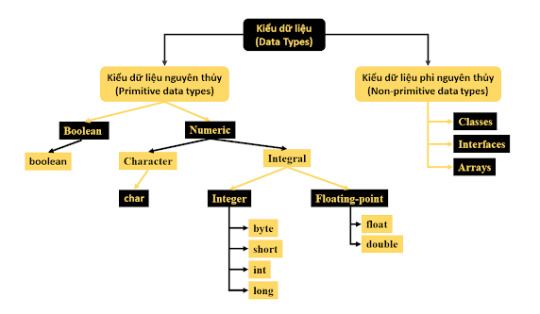
Ảnh mô tả hệ thống các kiểu dữ liệu trong Java
1. Kiểu Dữ Liệu Nguyên Thủy (Primitive Data Types)
Kiểu dữ liệu nguyên thủy là các kiểu dữ liệu cơ bản được định nghĩa sẵn trong Java. Chúng không phải là đối tượng và lưu trữ trực tiếp giá trị trong bộ nhớ. Có 8 kiểu dữ liệu nguyên thủy trong Java, bao gồm:
1.1. Kiểu số nguyên (Integer Types)
byte: Kích thước 1 byte, lưu trữ số nguyên từ -128 đến 127.
short: Kích thước 2 byte, lưu trữ số nguyên từ -32,768 đến 32,767.
int: Kích thước 4 byte, lưu trữ số nguyên từ -2^31 đến 2^31-1.
long: Kích thước 8 byte, lưu trữ số nguyên từ -2^63 đến 2^63-1.
Ví dụ:
int age = 25;
long population = 8000000000L;
1.2. Kiểu số thực (Floating-Point Types)
float: Kích thước 4 byte, lưu trữ số thực với độ chính xác đơn.
double: Kích thước 8 byte, lưu trữ số thực với độ chính xác kép.
Ví dụ:
double pi = 3.14159;
float temperature = 36.6f;
1.3. Kiểu ký tự (Character Type)
char: Kích thước 2 byte, lưu trữ một ký tự Unicode.
Ví dụ: char letter = 'A';
1.4. Kiểu logic (Boolean Type)
boolean: Lưu trữ hai giá trị true hoặc false.
Ví dụ: boolean is Student = true;
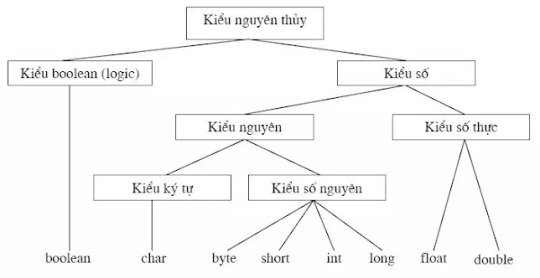
Bảng tóm tắt kiểu dữ liệu nguyên thủy
2. Kiểu Dữ Liệu Tham Chiếu (Reference Data Types)
Kiểu dữ liệu tham chiếu lưu trữ tham chiếu (địa chỉ) đến dữ liệu thay vì giá trị thực tế. Các kiểu này bao gồm:
Lớp (Class): Các đối tượng được tạo từ lớp, chẳng hạn như String, Scanner.
Giao diện (Interface): Các giao diện như List, Map.
Mảng (Array): Tập hợp các phần tử cùng kiểu dữ liệu.
Chuỗi (String): Một kiểu đặc biệt dùng để lưu trữ chuỗi ký tự.
Ví dụ:
String name = "Nguyen Van A";
int[] numbers = {1, 2, 3, 4, 5};
Đặc điểm của kiểu dữ liệu tham chiếu:
Có thể là null (không tham chiếu đến đối tượng nào).
Được lưu trữ trong Heap Memory và quản lý bởi Garbage Collector.
Hỗ trợ các phương thức và thuộc tính của đối tượng.

Heap Memory và Stack Memory
Khi Nào Nên Sử Dụng Kiểu Dữ Liệu Nào?
Sử dụng kiểu dữ liệu nguyên thủy khi cần lưu trữ các giá trị đơn giản như số, ký tự hoặc giá trị logic để tối ưu hóa hiệu suất.
Sử dụng kiểu dữ liệu tham chiếu khi làm việc với các đối tượng phức tạp, chuỗi hoặc mảng.
Ví dụ thực tế:
public class Example {
public static void main(String[] args) {
// Kiểu dữ liệu nguyên thủy
int age = 30;
double salary = 50000.75;
boolean isEmployed = true;
// Kiểu dữ liệu tham chiếu
String employeeName = "Tran Thi B";
int[] workingDays = {20, 22, 21};
System.out.println("Name: " + employeeName + ", Age: " + age + ", Salary: " + salary);
}
}
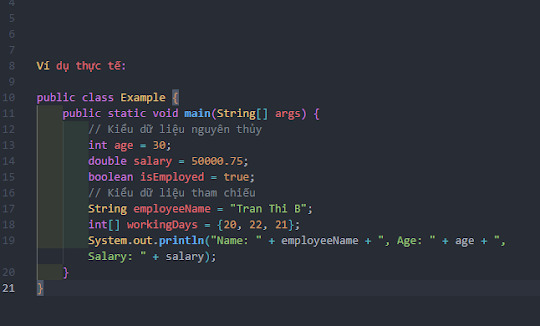
Mã nguồn ví dụ
Mẹo Tối Ưu Khi Làm Việc Với Kiểu Dữ Liệu Trong Java
Chọn kiểu dữ liệu phù hợp: Sử dụng byte hoặc short thay cho int nếu giá trị nhỏ để tiết kiệm bộ nhớ.
Hiểu rõ phạm vi giá trị: Tránh lỗi tràn số (overflow) khi làm việc với int hoặc long.
Sử dụng StringBuilder cho chuỗi lớn: Thay vì dùng String để nối chuỗi nhiều lần.
Kiểm tra null: Với kiểu dữ liệu tham chiếu, luôn kiểm tra giá trị null để tránh lỗi NullPointerException.
Kết Luận
Hiểu rõ kiểu dữ liệu trong Java là bước đầu tiên để viết mã hiệu quả và tránh lỗi không mong muốn. Kiểu dữ liệu nguyên thủy phù hợp với các giá trị đơn giản, trong khi kiểu dữ liệu tham chiếu cần thiết cho các đối tượng phức tạp. Hy vọng bài viết này đã cung cấp cho bạn cái nhìn tổng quan và những ví dụ thực tế để áp dụng trong lập trình Java.
Nếu bạn muốn tìm hiểu sâu hơn về kiểu dữ liệu hoặc các chủ đề khác trong Java, hãy để lại câu hỏi hoặc theo dõi các bài viết tiếp theo của chúng tôi!
Kiểu Dữ Liệu Trong Java – Phân Loại & Ví Dụ Dễ Hiểu Tìm hiểu các kiểu dữ liệu cơ bản và tham chiếu trong Java. Bao gồm ví dụ minh hoạ rõ ràng giúp bạn học nhanh và nhớ lâu! 🌍 Website: Java Highlight
#Kiểu Dữ Liệu Trong Java#JavaHighlight#KieuDuLieuJava#JavaDataTypes#JavaBasics#LapTrinhJava#Javalearning#JavaTutorial#PrimitiveTypes#ReferenceTypes#JavaTips#CodeJava
0 notes
Text
In-memory caching frameworks are an essential part of modern web application development. They allow developers to improve the performance of their applications by storing frequently accessed data in memory, reducing the need for expensive database queries. In-memory caching frameworks are used for a variety of purposes such as improving response times, reducing server load, and scaling applications. In this article, we have discussed ten popular in-memory caching frameworks used in web application development. We have covered both commercial and open-source solutions, with a focus on their features, capabilities, and use cases. By the end of this article, you will have a good understanding of the different in-memory caching frameworks available and be able to choose the one that best suits your application's needs. Redis Redis is an open-source, in-memory data structure store that is used as a database, cache, and message broker. Redis supports a wide range of data structures such as strings, hashes, lists, sets, sorted sets with range queries, bitmaps, hyperloglogs, and geospatial indexes with radius queries. Redis is highly scalable and has a high-performance, low-latency design, making it a popular choice for caching and data processing applications. Redis also supports a variety of programming languages including Java, Python, C#, and Node.js, making it a versatile choice for developers. Memcached Memcached is a high-performance, distributed memory object caching system that is used to speed up dynamic web applications. Memcached stores data in RAM and serves requests from memory, which makes it faster than traditional disk-based storage systems. Memcached is designed to be simple, fast, and scalable. It supports a variety of programming languages including C, C++, Java, Perl, Python, Ruby, and PHP. Memcached is used by many popular websites such as Facebook, Twitter, and YouTube to improve the performance of their web applications. Hazelcast Hazelcast is a distributed in-memory data grid that is used for scaling web applications and caching data. Hazelcast provides a distributed data structure, allowing data to be cached across multiple nodes, and supports distributed computing frameworks such as MapReduce, ExecutorService, and ForkJoinPool. Hazelcast is compatible with a wide range of programming languages including Java, C++, .NET, and Python, making it a versatile choice for developers. Hazelcast provides advanced features such as data partitioning, data replication, distributed locking, and distributed transactions. It is commonly used for caching data, session management, and distributed computing. Apache Ignite Apache Ignite is an in-memory computing platform that is used for distributed computing, data processing, and caching. Apache Ignite provides a distributed key-value store, allowing data to be cached across multiple nodes, and supports distributed SQL and distributed computing frameworks such as MapReduce and Spark. Apache Ignite is designed to be highly scalable, fault-tolerant, and low-latency. It supports a wide range of programming languages including Java, .NET, C++, and Python, and can be deployed in a variety of environments such as on-premise, cloud, and hybrid. Apache Ignite is commonly used for caching data, real-time analytics, and high-performance computing. Couchbase Couchbase is a NoSQL document database with built-in caching capabilities that is used for high-performance, scalable web applications. Couchbase provides an in-memory caching layer that stores frequently accessed data in RAM for faster access. Couchbase also provides advanced features such as data partitioning, data replication, and cross-datacenter replication. Couchbase supports a wide range of programming languages including Java, .NET, Node.js, Python, and Ruby, making it a versatile choice for developers. Couchbase is commonly used for caching data, real-time analytics, and high-performance computing.
Aerospike Aerospike is a high-performance, distributed NoSQL database with in-memory caching capabilities that is used for real-time applications. Aerospike provides a distributed key-value store that allows data to be cached across multiple nodes, and supports distributed computing frameworks such as MapReduce and Spark. Aerospike is designed to be highly scalable, fault-tolerant, and low-latency. It supports a wide range of programming languages including Java, .NET, C++, and Python, and can be deployed in a variety of environments such as on-premise, cloud, and hybrid. Aerospike provides advanced features such as data replication, data partitioning, and automatic data migration. It is commonly used for caching data, session management, and real-time analytics. GridGain GridGain is an in-memory computing platform that is used for distributed computing, data processing, and caching. GridGain provides a distributed key-value store that allows data to be cached across multiple nodes, and supports distributed computing frameworks such as MapReduce, Spark, and Storm. GridGain is designed to be highly scalable, fault-tolerant, and low-latency. It supports a wide range of programming languages including Java, .NET, C++, and Python, and can be deployed in a variety of environments such as on-premise, cloud, and hybrid. GridGain provides advanced features such as data replication, data partitioning, and automatic data migration. It is commonly used for caching data, real-time analytics, and high-performance computing. Oracle Coherence Oracle Coherence is an in-memory data grid that is used for distributed caching, data processing, and real-time analytics. Oracle Coherence provides a distributed key-value store that allows data to be cached across multiple nodes, and supports distributed computing frameworks such as MapReduce and Spark. Oracle Coherence is designed to be highly scalable, fault-tolerant, and low-latency. It supports a wide range of programming languages including Java, .NET, and C++, and can be deployed in a variety of environments such as on-premise, cloud, and hybrid. Oracle Coherence provides advanced features such as data partitioning, data replication, and distributed locking. It is commonly used for caching data, session management, and real-time analytics. Ehcache Ehcache is an open-source, Java-based, in-memory caching library that is used for caching data in Java applications. Ehcache provides a simple, lightweight caching solution that can be easily integrated into Java applications. Ehcache supports a variety of caching strategies such as time-based expiration, least recently used (LRU) eviction, and first in, first out (FIFO) eviction. Ehcache is designed to be highly scalable and supports distributed caching through its Terracotta add-on. Ehcache also supports a variety of Java frameworks such as Hibernate, Spring, and Struts, making it a popular choice for Java developers. Caffeine Caffeine is an open-source, Java-based, high-performance, in-memory caching library that is used for caching data in Java applications. Caffeine provides a simple, lightweight caching solution that can be easily integrated into Java applications. Caffeine supports a variety of caching strategies such as time-based expiration, least recently used (LRU) eviction, and first in, first out (FIFO) eviction. Caffeine is designed to be highly scalable and supports both single and multiple JVM (Java Virtual Machine) caching. Caffeine provides advanced features such as automatic cache population, asynchronous loading, and refresh-ahead caching. Caffeine is a popular choice for Java developers due to its high performance and low overhead. In-memory caching frameworks are a critical component of modern web application development. They enable developers to improve application performance, reduce server load, and scale applications. There are many in-memory caching frameworks available, both commercial and open-source, each with its own unique features and capabilities.
The choice of framework depends on the specific requirements of the application, including performance, scalability, and reliability. By understanding the different in-memory caching frameworks available, developers can make informed decisions and choose the best framework for their application's needs.
0 notes
Text
"Mastering string compareTo: How Strings Really Stack Up in Java"
Comparing two strings might sound like a basic task, but when it comes to programming—especially in Java—there’s more happening under the hood. Whether you’re sorting a list of names, validating user input, or organizing data alphabetically, the method string compareTo is your trusty sidekick.
In this blog, we’ll unpack how the compareTo method works, what it really compares, and when to use it in real-world scenarios. No code required—just a clear and practical understanding of one of Java’s most essential string tools.
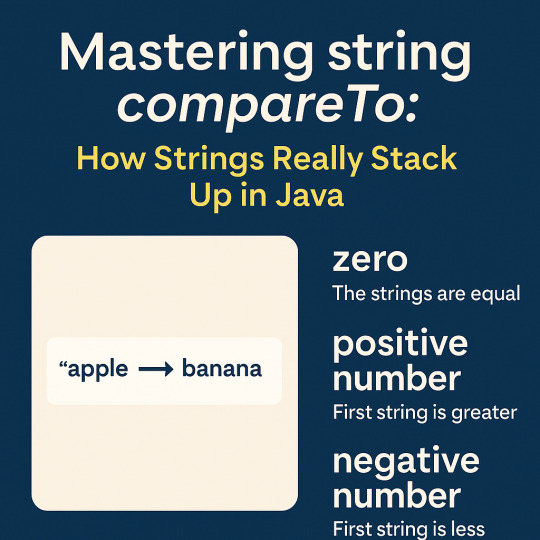
What Is string compareTo All About?
At its core, string compareTo is a method used to compare two strings lexicographically—that means it checks how they stack up in dictionary order. This method belongs to the String class in Java and returns an integer that tells you the result of the comparison.
But here’s where it gets interesting: it doesn’t just say "equal" or "not equal." Instead, it tells you how two strings differ in order, giving you valuable information you can use in sorting, decision-making, and data processing.
Breaking Down the CompareTo Results
When you compare two strings using string compareTo, Java returns one of three possible outcomes:
Zero (0): The strings are exactly the same.
A positive number: The first string is lexicographically greater than the second.
A negative number: The first string is lexicographically less than the second.
So when you see a result like -3 or 4, it’s not about the actual number—it’s about the sign (negative, zero, or positive) that matters most.
Lexicographical Comparison: What Does That Really Mean?
"Lexicographical" might sound fancy, but it’s basically how words are ordered in the dictionary. Java compares strings character by character, based on their Unicode values.
Let’s imagine comparing “Apple” to “Banana”:
“A” comes before “B” in the alphabet.
Therefore, "Apple".compareTo("Banana") will return a negative number.
This rule applies even if the strings are almost identical. For example:
"Code" vs "Coder" → The shorter one comes first if all earlier characters match.
It’s like comparing two paths in a forest: you walk together until one path splits off—whichever turns first determines which one is “greater” or “less.”
When and Why You’d Use string compareTo
You might be wondering: where does this comparison method actually come in handy? Here are a few common use cases:
1. Sorting Strings
Whether you’re building a contact list or sorting categories alphabetically, string compareTo helps establish the order. Most sorting algorithms under the hood rely on such comparisons to figure out which string should come first.
2. Validating Input
Need to check if a user typed the exact phrase you're expecting? Using string compareTo is one way to verify input matches your criteria without relying on basic equality checks alone.
3. Creating Custom Sorting Logic
In more advanced scenarios, you might sort strings based on specific business rules. For example, ignoring case or placing certain words before others. While compareTo gives you a default behavior, it can be extended with custom logic when needed.
Things to Keep in Mind
As helpful as string compareTo is, here are a few nuances to remember:
Case Sensitivity Matters: "apple" and "Apple" will not be considered equal. The method is case-sensitive by default.
Null Safety: Avoid comparing strings that might be null, as calling compareTo on a null reference will throw an exception.
Consistency Counts: Always use a consistent comparison strategy, especially when dealing with sorted data structures or search functions.
If you need to compare strings without case sensitivity, many developers opt to convert both strings to lowercase or uppercase before comparing them.
Alternatives and Enhancements
Sometimes, the basic string compareTo isn’t quite enough. For example, if you want to:
Ignore case: Use a method designed for case-insensitive comparison.
Handle locales and special characters: Use a more advanced comparison mechanism like Collator for culturally aware sorting.
But in most situations, string compareTo provides exactly what you need in a lightweight and reliable way.
Final Thoughts: Comparing the Right Way
String comparison may seem simple on the surface, but understanding how methods like string compareTo work gives you greater control over how your application behaves. It's one of those hidden gems in programming—subtle, powerful, and essential in the right hands.
Next time you find yourself sorting, filtering, or validating text in your Java programs, remember this: knowing how strings stack up can make all the difference.
With a solid grasp of string compareTo, you’re well on your way to writing cleaner, smarter, and more predictable code.
0 notes
Text
Java Programming for Beginners

Java is a powerful, object-oriented programming language used to build everything from web apps and mobile apps to desktop software and enterprise systems. If you're just starting your programming journey, Java is a great language to learn. This guide introduces you to the basics and helps you take your first steps with confidence.
Why Learn Java?
Platform Independent: Java code runs on any device with a Java Virtual Machine (JVM).
Object-Oriented: Encourages clean, modular, and scalable code.
Wide Usage: Used in Android development, enterprise software, games, and more.
Strong Community: Huge ecosystem with thousands of libraries and tools.
Setting Up Java
Download and install the Java Development Kit (JDK).
Install an IDE (like IntelliJ IDEA, Eclipse, or VS Code).
Write your first Java program!
Your First Java Program
public class HelloWorld { public static void main(String[] args) { System.out.println("Hello, world!"); } }
This simple program prints "Hello, world!" to the console — the classic first step for all programmers!
Key Java Concepts
Variables: Used to store data (e.g., int age = 25;)
Data Types: int, float, double, boolean, String, etc.
Control Structures: if, else, switch, for loop, while loop
Methods: Functions that define behavior
Classes & Objects: The foundation of object-oriented programming
Example: A Simple Java Class
public class Car { String brand; int year; public void drive() { System.out.println(brand + " is driving."); } }
Practice Ideas for Beginners
Create a calculator using basic math operations
Build a simple to-do list console app
Write a program that checks if a number is prime
Make a guessing game with loops and conditions
Helpful Resources to Learn Java
W3Schools Java Tutorial
Codecademy Java Course
GeeksforGeeks Java Section
Official Java Tutorials
Conclusion
Java is a reliable and versatile language that will serve you well throughout your software development journey. Start with the basics, practice consistently, and don’t be afraid to experiment and break things — that’s how real learning happens!
0 notes
Text
LDAP testing & defense
LDAP Injection is an attack used to exploit web based applications that construct LDAP statements based on user input. When an application fails to properly sanitize user input, it's possible to modify LDAP statements through techniques similar to SQL Injection.
LDAP injection attacks are common due to two factors:
The lack of safer, parameterized LDAP query interfaces
The widespread use of LDAP to authenticate users to systems.
How to test for the issue
During code review
Please check for any queries to the LDAP escape special characters, see here.
Automated Exploitation
Scanner module of tool like OWASP ZAP have module to detect LDAP injection issue.
Remediation
Escape all variables using the right LDAP encoding function
The main way LDAP stores names is based on DN (distinguished name). You can think of this like a unique identifier. These are sometimes used to access resources, like a username.
A DN might look like this
cn=Richard Feynman, ou=Physics Department, dc=Caltech, dc=edu
or
uid=inewton, ou=Mathematics Department, dc=Cambridge, dc=com
There are certain characters that are considered special characters in a DN. The exhaustive list is the following: \ # + < > , ; " = and leading or trailing spaces
Each DN points to exactly 1 entry, which can be thought of sort of like a row in a RDBMS. For each entry, there will be 1 or more attributes which are analogous to RDBMS columns. If you are interested in searching through LDAP for users will certain attributes, you may do so with search filters. In a search filter, you can use standard boolean logic to get a list of users matching an arbitrary constraint. Search filters are written in Polish notation AKA prefix notation.
Example:
(&(ou=Physics)(| (manager=cn=Freeman Dyson,ou=Physics,dc=Caltech,dc=edu) (manager=cn=Albert Einstein,ou=Physics,dc=Princeton,dc=edu) ))
When building LDAP queries in application code, you MUST escape any untrusted data that is added to any LDAP query. There are two forms of LDAP escaping. Encoding for LDAP Search and Encoding for LDAP DN (distinguished name). The proper escaping depends on whether you are sanitising input for a search filter, or you are using a DN as a username-like credential for accessing some resource.
Safe Java for LDAP escaping Example:
public String escapeDN (String name) {
//From RFC 2253 and the / character for JNDI
final char[] META_CHARS = {'+', '"', '<', '>', ';', '/'};
String escapedStr = new String(name);
//Backslash is both a Java and an LDAP escape character,
//so escape it first escapedStr = escapedStr.replaceAll("\\\\\\\\","\\\\\\\\");
//Positional characters - see RFC 2253
escapedStr = escapedStr.replaceAll("\^#","\\\\\\\\#");
escapedStr = escapedStr.replaceAll("\^ | $","\\\\\\\\ ");
for (int i=0 ; i < META_CHARS.length ; i++) {
escapedStr = escapedStr.replaceAll("\\\\" + META_CHARS[i],"\\\\\\\\" + META_CHARS[i]);
}
return escapedStr;
}
3 notes
·
View notes
Text
How to Master Java Fast: A Hands-On Approach
Java is a powerful and versatile programming language used in web development, mobile applications, and enterprise solutions. Whether you're a beginner or looking to refine your skills, mastering Java quickly requires a structured, hands-on approach. Instead of just reading theory, practicing real-world coding scenarios is the key to accelerating your learning. Enrolling in a Java Training in Bangalore significantly enhances one’s ability to leverage Java’s capabilities effectively.

This guide will walk you through an effective roadmap to mastering Java fast.
Set Up Your Java Development Environment
Before diving into coding, ensure you have the right tools in place. Install the Java Development Kit (JDK), which is essential for compiling and running Java programs. Choose an Integrated Development Environment (IDE) like IntelliJ IDEA, Eclipse, or NetBeans to make coding more efficient with features like code suggestions and debugging tools. Setting up your environment correctly will allow you to focus on learning rather than troubleshooting installation issues.
Master Java Fundamentals First
A strong foundation in Java’s basics is crucial before moving to advanced topics. Start by understanding variables and data types, including integers, strings, and booleans. Learn about operators, such as arithmetic, relational, and logical operators, and how they help perform calculations and comparisons. Control flow structures like if-else statements, loops (for, while, do-while), and switch cases allow you to implement decision-making in your programs. Instead of just reading about these concepts, practice writing small programs to see them in action.
Adopt an Object-Oriented Programming Mindset
Java is built on the principles of object-oriented programming, which makes your code reusable and scalable. Focus on four key concepts:
Classes and objects form the foundation of Java programming.
Encapsulation protects data using access modifiers.
Inheritance enables code reuse by allowing one class to inherit from another.
Polymorphism allows one interface to be used for multiple implementations.
Create real-world projects using object-oriented principles, such as a student management system or an inventory management tool, to reinforce these concepts. It’s simpler to master this tool and progress your profession with the help of Best Online Training & Placement Programs, which provide thorough instruction and job placement support to anyone seeking to improve their talents.
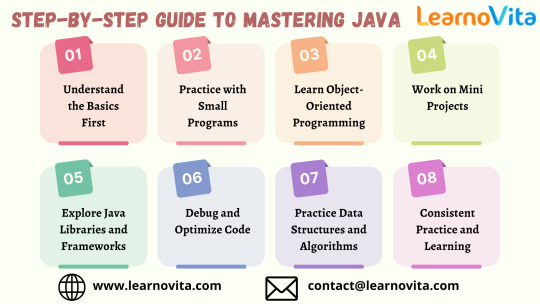
Work on Real-Life Java Projects
The fastest way to learn Java is by building projects that mimic real-world applications. Start small, then progress to more complex applications. Some project ideas include:
A to-do list application that uses basic input/output and file handling.
A banking system that implements object-oriented concepts like classes and inheritance.
A weather app that fetches real-time weather data using APIs.
A chat application that introduces networking in Java.
By applying concepts in practical scenarios, you’ll gain confidence and a deeper understanding of Java programming.
Get Comfortable with Java Libraries and APIs
Java offers a wide range of built-in libraries that simplify development. Some of the most important ones include:
java.util contains data structures like lists, sets, and maps.
java.io handles file input and output operations.
java.net manages network programming tasks.
java.sql helps interact with databases using JDBC.
Mastering these libraries will make coding more efficient and allow you to build powerful applications.
Understand Exception Handling and Debugging
Errors are inevitable when coding, but Java’s exception-handling mechanism ensures smooth program execution. Learn how to use try-catch blocks to handle errors gracefully. The finally block ensures critical code runs regardless of exceptions. Debugging is another essential skill—practice using debugging tools in your IDE to identify and fix issues efficiently.
Explore Java Frameworks for Faster Development
Once you're comfortable with core Java, learning frameworks can speed up development. Some of the most widely used Java frameworks include:
Spring Boot for building enterprise-level applications.
Hibernate simplifies database interactions with object-relational mapping.
Apache Maven manages project dependencies and builds.
JUnit is used for testing Java applications.
Exploring these frameworks will make you job-ready and improve your efficiency as a Java developer.
Practice Coding Daily and Solve Challenges
The best way to master Java quickly is to code every day. Solve Java coding challenges on platforms like LeetCode, HackerRank, and CodeChef. These platforms offer algorithm-based problems that sharpen problem-solving skills. Additionally, contributing to open-source projects on GitHub can help you gain real-world experience.
Join Java Communities and Seek Mentorship
Engaging with Java communities can provide invaluable learning opportunities. Join forums like Stack Overflow, Java Reddit, and GitHub Discussions to ask questions and learn from experienced developers. If possible, find a mentor who can guide you through challenging concepts and best coding practices.
Final Thoughts
Mastering Java quickly requires a hands-on, structured approach. By setting up your environment, focusing on core concepts, building projects, and practicing regularly, you can accelerate your learning journey. Remember, consistency is key—keep coding, keep exploring, and soon you'll be a confident Java developer ready to take on exciting projects!
0 notes
Text
10 Must-Learn Programming Concepts for Absolute Beginners

Learning to code can feel overwhelming, but mastering these 10 fundamental programming concepts will give you a strong foundation. Whether you're learning Python, JavaScript, or any other language, these principles apply everywhere!
1. Variables & Data Types
Variables store data, and understanding types (like integers, strings, booleans) is crucial. 📌 Example: name = "Alice" (Python)
2. Conditional Statements (If/Else)
Programs make decisions using if, else if, and else.
📌 Example:
if age >= 18:
print("Adult")
else:
print("Minor")
3. Loops (For & While)
Automate repetitive tasks with loops. 📌 Example: Printing numbers 1 to 5:
python
for i in range(1, 6):
print(i)
4. Functions Reusable blocks of code that perform specific tasks. 📌 Example:
python
def greet(name):
return f"Hello, {name}!"
5. Arrays/Lists
Collections of data that can be modified. 📌 Example: fruits = ["apple", "banana"]
6. Object-Oriented Programming (OOP) Organize code using classes and objects. (Key for languages like Java & Python)
7. Error Handling (Try/Except)
Prevent crashes by managing errors gracefully.
8. Algorithms & Basic Problem-Solving
Learn sorting, searching, and logic-building techniques.
9. Version Control (Git & GitHub)
Track code changes and collaborate with others.
10. Debugging Techniques Fixing errors using print statements, debuggers, and logging.
Want to Learn These Concepts in Depth? If you're serious about coding, check out my beginner-friendly programming courses that break down these concepts step by step!
0 notes